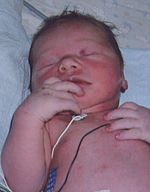Blue baby syndrome
Blue-baby syndrome, or blue baby is usually caused by a heart defect which laymen often call "a hole in the heart". The foramen ovale is an aperture between the walls of the right and left atrium in the fetus that allows the blood too cross the atria and help in bypass pulmonary blood circulation. In normal cases this aperture closes in the babies after birth. But in case of an abnormality sometimes this aperture does not close resulting in the bypass to continue, which is not needed after the baby starts breathing on its own. [1]Normally, oxygenated blood from the lungs is separated from deoxygenated blood from other tissues. Because of the defect in the heart ventricular-atrial wall, deoxygenated blood sometimes mixes with the blood from the lungs. The resulting blood going through the aorta has less oxygen than usual. The baby then looks blue. An operation is usually done to close the aperture resulting in a normal flow of the blood.


There are several heart defects which produce this syndrome. There are also some causes which are not related to heart conditions.
On November 29, 1944, the first successful operation for the heart condition was done at the Johns Hopkins Hospital.[2] In 1976, the university awarded the surgeon an honorary doctorate.[3]
References
change- ↑ "Nemours KidsHealth - the Web's most visited site about children's health". kidshealth.org (in Spanish). Retrieved 2024-06-26.
- ↑ "Hopkins pioneered 'blue baby' surgery 50 years ago 'I remember ... thinking tt was impossible'". Retrieved 2008-03-24.
- ↑ "Vivien T. Thomas, L.L.D." Medical archives. Johns Hopkins Medical Institutions. Archived from the original on 13 July 2018. Retrieved 18 March 2014.
- http://www.medicinenet.com/script/main/art.asp?articlekey=24529 Archived 2017-03-14 at the Wayback Machine